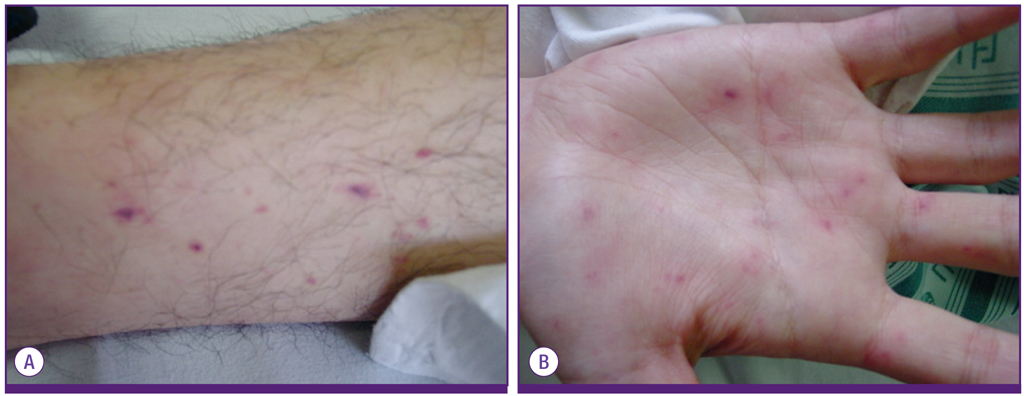Infect Chemother.
2013 Mar;45(1):94-98.
A Case of Meningococcal Sepsis and Meningitis with Complement 7 Deficiency in a Military Trainee
- Affiliations
-
- 1Department of Internal Medicine, Seoul National University Hospital, Seoul, Korea.
- 2Department of Internal Medicine, Armed Forces Capital Hospital, Seongnam, Korea. choekw@snu.ac.kr
- 3Department of Laboratory Medicine, Seoul National University Hospital, Seoul, Korea.
Abstract
- Complement component 7 (C7) deficiency leads to the loss of complement lytic function, and affected patients show increased susceptibility to encapsulated organisms infection, especially Neisseria meningitidis. Recently, we have experienced a 20-year-old military trainee with meningococcal sepsis and meningitis who was diagnosed as having C7 deficiency based upon the undetectable serum C7 protein on radioimmunoassay. This case emphasizes that although C7 deficiency is rare immune disorder, it is important to be aware of possibility about late complement deficiency among patients who present with meningococcal disease.
MeSH Terms
Figure
Reference
-
1. Rosenstein NE, Perkins BA, Stephens DS, Popovic T, Hughes JM. Meningococcal disease. N Engl J Med. 2001. 344:1378–1388.
Article2. Rosenstein NE, Perkins BA, Stephens DS, Lefkowitz L, Cartter ML, Danila R, Cieslak P, Shutt KA, Popovic T, Schuchat A, Harrison LH, Reingold AL. The changing epidemiology of meningococcal disease in the United States, 1992-1996. J Infect Dis. 1999. 180:1894–1901.
Article3. Figueroa JE, Densen P. Infectious diseases associated with complement deficiencies. Clin Microbiol Rev. 1991. 4:359–395.
Article4. We HW, Kim WD, Lee SJ, Lee DS, Kim DK, Choi SM, Ha GY. A case of hereditary C7 deficiency associated with meningococcal meningitis. Korean J Pediatr. 2004. 47:799–802.5. Choi SM, Lee KY, Lee HS, Hong JH, Lee MH, Lee BC. A case of meningococcal meningitis with complement 9 deficiency. Korean J Pediatr. 2005. 48:101–103.6. Kwon SM, Lee GH, Park KK. A case of membranoproliferative glomerulonephritis associated with complement deficiency and meningococcal meningitis. J Korean Soc Pediatr Nephrol. 2006. 10:45–51.7. Kim MK, Lee KY, Lee JH. A Korean familial case of hereditary complement 7 deficiency. Korean J Pediatr. 2009. 52:721–724.
Article8. Fijen CA, Bredius RG, Kuijper EJ, Out TA, De Haas M, De Wit AP, Daha MR, De Winkel JG. The role of Fcgamma receptor polymorphisms and C3 in the immune defence against Neisseria meningitidis in complement-deficient individuals. Clin Exp Immunol. 2000. 120:338–345.
Article9. Pollard AJ, Frasch C. Development of natural immunity to Neisseria meningitidis. Vaccine. 2001. 19:1327–1346.
Article10. Hoare S, El-Shazali O, Clark JE, Fay A, Cant AJ. Investigation for complement deficiency following meningococcal disease. Arch Dis Child. 2002. 86:215–217.
Article11. Densen P. Complement deficiencies and meningococcal disease. Clin Exp Immunol. 1991. 86:Suppl 1. 57–62.
Article12. Figueroa J, Andreoni J, Densen P. Complement deficiency states and meningococcal disease. Immunol Res. 1993. 12:295–311.
Article13. Fijen CA, Kuijper EJ, te Bulte MT, Daha MR, Dankert J. Assessment of complement deficiency in patients with meningococcal disease in The Netherlands. Clin Infect Dis. 1999. 28:98–105.
Article14. Schwartz B, Moore PS, Broome CV. Global epidemiology of meningococcal disease. Clin Microbiol Rev. 1989. 2:Suppl. S118–S124.
Article15. Connolly M, Noah N. European Meningitis Surveillance Group. Is group C meningococcal disease increasing in Europe? A report of surveillance of meningococcal infection in Europe 1993-6. Epidemiol Infect. 1999. 122:41–49.
Article16. Lee SO, Ryu SH, Park SJ, Ryu JS, Woo JH, Kim YS. Meningococcal disease in the republic of Korea army: incidence and serogroups determined by PCR. J Korean Med Sci. 2003. 18:163–166.
Article17. Bae SM, Kang YH. Serological and genetic characterization of meningococcal isolates in Korea. Jpn J Infect Dis. 2008. 61:434–437.18. Wolf RE, Birbara CA. Meningococcal infections at an army training center. Am J Med. 1968. 44:243–255.
Article19. Bilukha OO, Rosenstein N. National Center for Infectious Diseases, Centers for Disease Control and Prevention (CDC). Prevention and control of meningococcal disease. Recommendations of the Advisory Committee on Immunization Practices (ACIP). MMWR Recomm Rep. 2005. 54:1–21.
- Full Text Links
- Actions
-
Cited
- CITED
-
- Close
- Share
- Similar articles
-
- A Case of Meningococcal Meningitis with Complement 9 Deficiency
- A Case of Deficiency of the Seventh Component of Complement with Recurrence of Meningococcal Meningitis and Septicemia
- A Korean familial case of hereditary complement 7 deficiency
- A Case of Hereditary C7 Deficiency Associated with Meningococcal Meningitis
- Meningococcal Cellulitis in a Patient with Systemic Lupus Erythematosus


